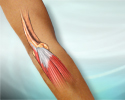Elbow pain
Pain - elbow
This article describes pain or other discomfort in the elbow that is not related to direct injury.
Causes
Elbow pain can be caused by many problems. A common cause in adults is tendinitis. This is inflammation and injury to the tendons, which are soft tissues that attach muscle to bone.
People who play racquet sports are most likely to injure the tendons on the outside of the elbow. This condition is commonly called tennis elbow. Golfers are more likely to injure the tendons on the inside of the elbow.
Other common causes of elbow tendinitis are gardening, playing baseball, using a screwdriver, or overusing your wrist and arm.
Young children commonly develop "nursemaid elbow," which often occurs when someone is pulling on their straightened arm. The bones are stretched apart momentarily and a ligament slips in between. It becomes trapped when the bones try to snap back into place. As a result, the child will usually quietly refuse to use the arm, but often cries out when they try to bend or straighten the elbow. This condition is also called an elbow subluxation (a partial dislocation). This often gets better on its own when the ligament slips back into place. Surgery is usually not needed.
Other common causes of elbow pain are:
- Bursitis -- inflammation of a fluid-filled cushion beneath the skin
- Arthritis -- narrowing of the joint space and loss of cartilage in the elbow
- Elbow strains
- Infection of the elbow
- Tendon tears -- biceps rupture
Home Care
Gently try to move the elbow and increase your range of motion. If this hurts or you cannot move the elbow, contact your health care provider.
When to Contact a Medical Professional
Contact your provider if:
- You have a prolonged case of tendinitis that doesn't improve with home care.
- The pain is due to a direct elbow injury.
- There is obvious deformity.
- You can't use or move the elbow.
- You have fever or swelling and redness of your elbow.
- Your elbow is locked and can't straighten or bend.
- A child has elbow pain.
- There is a lot of swelling and bruising around the elbow.
What to Expect at Your Office Visit
Your provider will examine you and carefully check your elbow. You will be asked about your medical history and symptoms such as:
- Are both elbows affected?
- Does the pain shift from the elbow to other joints?
- Is the pain over the outside bony prominence of the elbow?
- Did the pain begin suddenly and severely?
- Did the pain begin slowly and mildly and then get worse?
- Is the pain getting better on its own?
- Did the pain begin after an injury?
- What makes the pain better or worse?
- Is there pain that goes from the elbow down to the hand?
Treatment depends on the cause, but may involve:
- Physical therapy
- Antibiotics
- Corticosteroid shots
- Manipulation
- Pain medicine
- Surgery (last resort)
References
Clark NJ, Elhassan BT. Elbow diagnosis and decision making. In: Miller MD, Thompson SR, eds. DeLee Drez & Miller's Orthopaedic Sports Medicine. 5th ed. Philadelphia, PA: Elsevier; 2020:chap 58.
Kane SF, Lynch JH, Taylor JC. Evaluation of elbow pain in adults. Am Fam Physician. 2014;89(8):649-657. PMID: 24784124 pubmed.ncbi.nlm.nih.gov/24784124/.
Lazinski M, Lazinski M, Fedorczyk JM. Clinical examination of the elbow. In: Skirven TM, Osterman AL, Fedorczyk JM, Amadio PC, Feldscher SB, Shin EK, eds. Rehabilitation of the Hand and Upper Extremity. 7th ed. Philadelphia, PA: Elsevier; 2021:chap 7.
Review Date: 9/20/2022
Reviewed By: C. Benjamin Ma, MD, Professor, Chief, Sports Medicine and Shoulder Service, UCSF Department of Orthopaedic Surgery, San Francisco, CA. Also reviewed by David C. Dugdale, MD, Medical Director, Brenda Conaway, Editorial Director, and the A.D.A.M. Editorial team.


